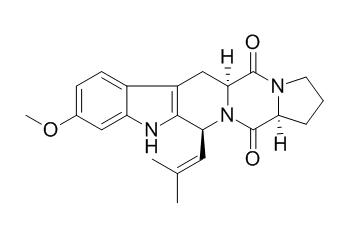Fumitremorgin C
Fumitremorgin C is a potent and specific chemosensitizing agent in cell lines selected for resistance to mitoxantrone that do not overexpress P-glycoprotein or multidrug resistance protein, it reverses multidrug resistance in cells transfected with the breast cancer resistance protein.Fumitremorgin C shows cytotoxic activity against HCT-116 tumour cell line. Fumitremorgin C shows an antibacterial activity against Staphylococcus aureus, methicillin-resistant S. aureus, and multidrug-resistant S. aureus.
Inquire / Order:
manager@chemfaces.com
Technical Inquiries:
service@chemfaces.com
Tel:
+86-27-84237783
Fax:
+86-27-84254680
Address:
1 Building, No. 83, CheCheng Rd., Wuhan Economic and Technological Development Zone, Wuhan, Hubei 430056, PRC
Providing storage is as stated on the product vial and the vial is kept tightly sealed, the product can be stored for up to
24 months(2-8C).
Wherever possible, you should prepare and use solutions on the same day. However, if you need to make up stock solutions in advance, we recommend that you store the solution as aliquots in tightly sealed vials at -20C. Generally, these will be useable for up to two weeks. Before use, and prior to opening the vial we recommend that you allow your product to equilibrate to room temperature for at least 1 hour.
Need more advice on solubility, usage and handling? Please email to: service@chemfaces.com
The packaging of the product may have turned upside down during transportation, resulting in the natural compounds adhering to the neck or cap of the vial. take the vial out of its packaging and gently shake to let the compounds fall to the bottom of the vial. for liquid products, centrifuge at 200-500 RPM to gather the liquid at the bottom of the vial. try to avoid loss or contamination during handling.
Exp Parasitol.2017, 183:160-166
Food Chemistry2023, 137837.
Curr Issues Mol Biol.2023, ;45(2):1601-1612.
Food Chem.2018, 252:207-214
Int J Mol Sci.2015, 16(1):1232-51
Biomed Chromatogr.2022, 36(11):e5462.
Antioxidants (Basel).2024, 13(3):340.
Heliyon.2022, e12337.
Foods.2021, 10(6):1378.
Synthetic and Systems Biotechnology2023, j.synbio.
Related and Featured Products
Cancer Res. 2000 Jan 1;60(1):47-50.
Fumitremorgin C reverses multidrug resistance in cells transfected with the breast cancer resistance protein.[Pubmed:
10646850]
Fumitremorgin C (FTC) is a potent and specific chemosensitizing agent in cell lines selected for resistance to mitoxantrone that do not overexpress P-glycoprotein or multidrug resistance protein.
METHODS AND RESULTS:
The gene encoding a novel transporter, the breast cancer resistance protein (BCRP), was recently found to be overexpressed in a mitoxantrone-selected human colon cell line, S1-M1-3.2, which was used to identify FTC. Because the drug-selected cell line may contain multiple alterations contributing to the multidrug resistance phenotype, we examined the effect of FTC on MCF-7 cells transfected with the BCRP gene.
CONCLUSIONS:
We report that FTC almost completely reverses resistance mediated by BCRP in vitro and is a pharmacological probe for the expression and molecular action of this transporter.
Natural Product Sciences, 2007,13(3):251-4.
12,13-Dihydroxyfumitremorgin C, Fumitremorgin C, and Brevianamide F, Antibacterial Diketopiperazine Alkaloids from the Marine-Derived Fungus Pseudallescheria sp.[Reference:
WebLink]
METHODS AND RESULTS:
Dioxopiperazine alkaloids, 12R,13S-dihydroxyFumitremorgin C (1), Fumitremorgin C (2), and brevianamide F (3), were isolated from the marine-derived fungus Pseudallescheria, and the absolute stereostructures of compounds 1 - 3 were elucidated on the basis of chemical and physicochemical evidence.
CONCLUSIONS:
Compounds 1 - 3 showed an antibacterial activity against Staphylococcus aureus, methicillin-resistant S. aureus, and multidrug-resistant S. aureus. The MIC (minimum inhibitory concentration) values of compounds 1 - 3 were 125 ug/ml for all strains.
Nat Prod Res. 2015;29(16):1545-50.
Cytotoxic compounds from the marine-derived fungus Aspergillus sp. recovered from the sediments of the Brazilian coast.[Pubmed:
25532964 ]
METHODS AND RESULTS:
A fungal strain of Aspergillus sp. (BRF 030) was isolated from the sediments collected in the northeast coast of Brazil, and the cytotoxic activity of its secondary metabolites was investigated against HCT-116 tumour cell line. The cytotoxicity-guided fractionation of the extracts from this fungus cultured in potato-dextrose-sea water for 14 days at room temperature yielded the hetero-spirocyclic γ-lactams pseurotin A (1), pseurotin D (2) and pseurotin FD-838 (7), the alkaloids Fumitremorgin C (5), 12,13-dihydroxy Fumitremorgin C (6), methylsulochrin (4) and bis(dethio)bis(methylthio)gliotoxin (3). Among them, Fumitremorgin C (5) and 12,13-dihydroxy Fumitremorgin C (6) were the most active.
The cytotoxic activities of the extracts from Aspergillus sp. grown from 7 to 28 days were investigated, and they were associated with the kinetic production of the compounds.
CONCLUSIONS:
The most active extracts (14 and 21 days) were those with the highest relative concentrations of the compounds Fumitremorgin C (5) and 12,13-dihydroxy Fumitremorgin C (6).



